Critical Analysis of Human Resource Management Challenges for Managers
VerifiedAdded on 2022/11/24
|8
|2856
|89
Report
AI Summary
This report presents a comprehensive analysis of the challenges encountered in human resource management (HRM) from a critical thinking perspective. The assignment begins with a speech addressing difficulties in hiring, employee training, and retention. The speech emphasizes the importance of addressing these issues for organizational success and suggests solutions such as improving hiring processes, providing adequate training, and offering attractive incentives for retention. Part Two provides a reflection on the speech, discussing the effective use of language, repetition, clarity, and verbal skills. The author highlights the simplicity of the language used, the strategic incorporation of repetition to emphasize key points, the clarity and precision in presenting the challenges and solutions, and the use of appropriate verbal techniques to engage the audience. Overall, the report provides a detailed examination of HRM challenges and strategies for effective management.
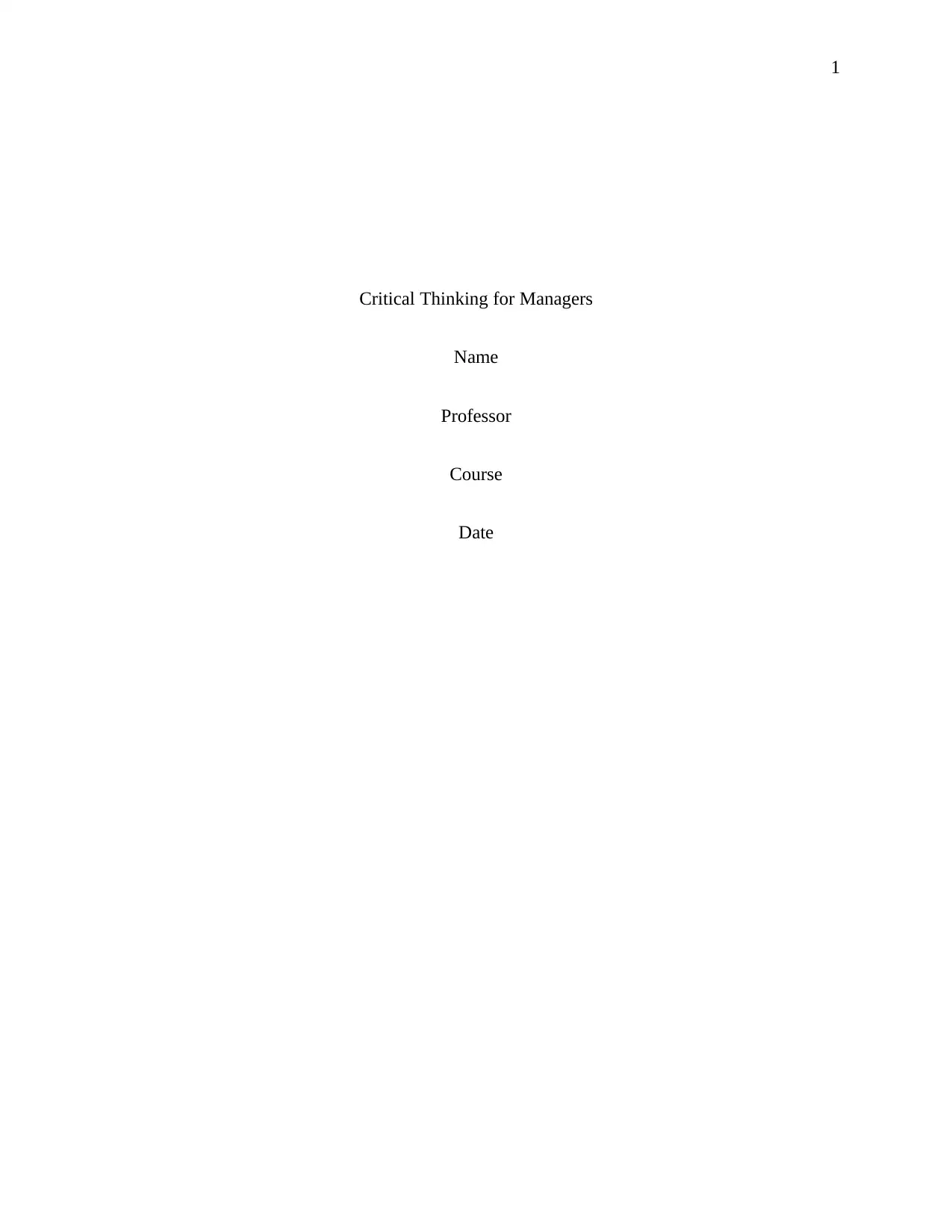
1
Critical Thinking for Managers
Name
Professor
Course
Date
Critical Thinking for Managers
Name
Professor
Course
Date
Paraphrase This Document
Need a fresh take? Get an instant paraphrase of this document with our AI Paraphraser
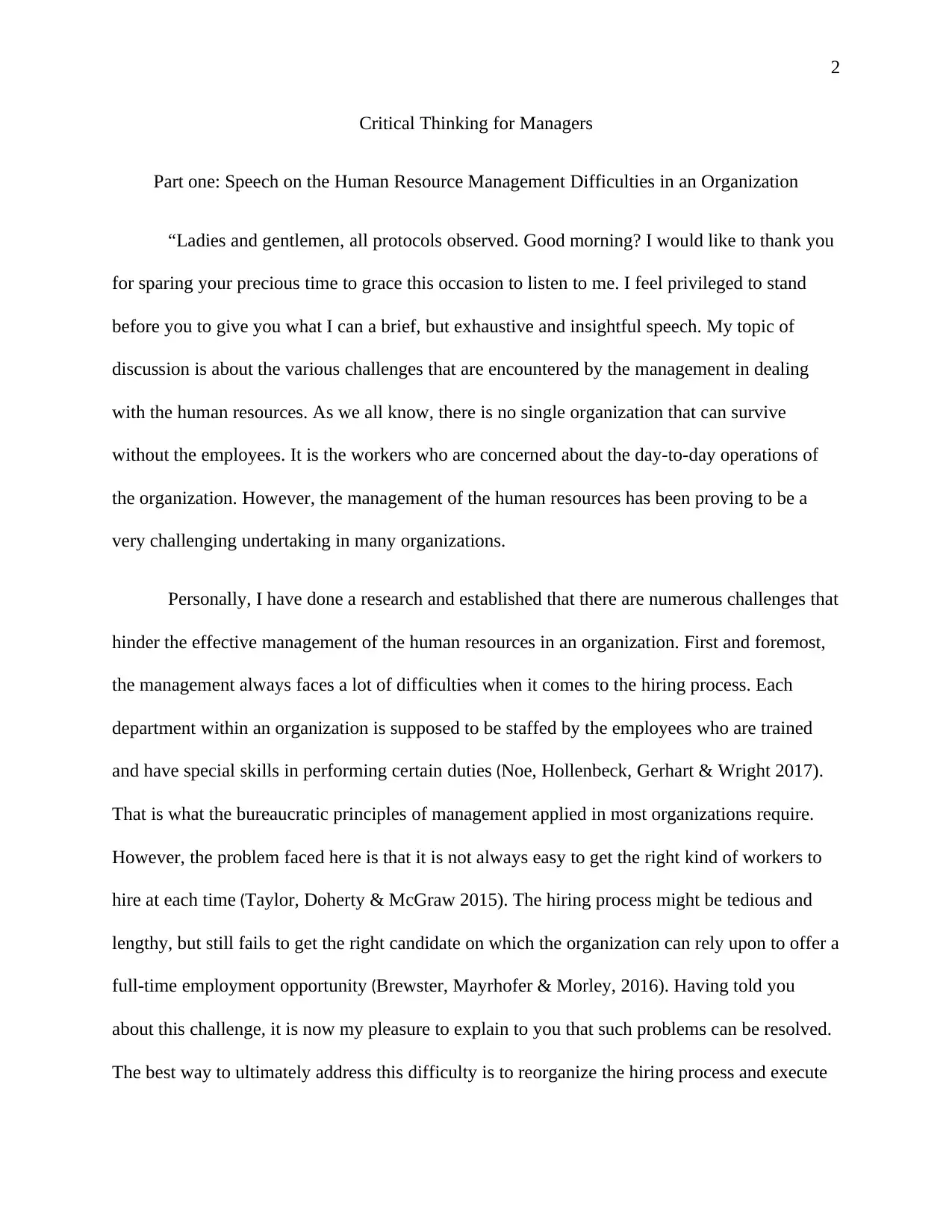
2
Critical Thinking for Managers
Part one: Speech on the Human Resource Management Difficulties in an Organization
“Ladies and gentlemen, all protocols observed. Good morning? I would like to thank you
for sparing your precious time to grace this occasion to listen to me. I feel privileged to stand
before you to give you what I can a brief, but exhaustive and insightful speech. My topic of
discussion is about the various challenges that are encountered by the management in dealing
with the human resources. As we all know, there is no single organization that can survive
without the employees. It is the workers who are concerned about the day-to-day operations of
the organization. However, the management of the human resources has been proving to be a
very challenging undertaking in many organizations.
Personally, I have done a research and established that there are numerous challenges that
hinder the effective management of the human resources in an organization. First and foremost,
the management always faces a lot of difficulties when it comes to the hiring process. Each
department within an organization is supposed to be staffed by the employees who are trained
and have special skills in performing certain duties (Noe, Hollenbeck, Gerhart & Wright 2017).
That is what the bureaucratic principles of management applied in most organizations require.
However, the problem faced here is that it is not always easy to get the right kind of workers to
hire at each time (Taylor, Doherty & McGraw 2015). The hiring process might be tedious and
lengthy, but still fails to get the right candidate on which the organization can rely upon to offer a
full-time employment opportunity (Brewster, Mayrhofer & Morley, 2016). Having told you
about this challenge, it is now my pleasure to explain to you that such problems can be resolved.
The best way to ultimately address this difficulty is to reorganize the hiring process and execute
Critical Thinking for Managers
Part one: Speech on the Human Resource Management Difficulties in an Organization
“Ladies and gentlemen, all protocols observed. Good morning? I would like to thank you
for sparing your precious time to grace this occasion to listen to me. I feel privileged to stand
before you to give you what I can a brief, but exhaustive and insightful speech. My topic of
discussion is about the various challenges that are encountered by the management in dealing
with the human resources. As we all know, there is no single organization that can survive
without the employees. It is the workers who are concerned about the day-to-day operations of
the organization. However, the management of the human resources has been proving to be a
very challenging undertaking in many organizations.
Personally, I have done a research and established that there are numerous challenges that
hinder the effective management of the human resources in an organization. First and foremost,
the management always faces a lot of difficulties when it comes to the hiring process. Each
department within an organization is supposed to be staffed by the employees who are trained
and have special skills in performing certain duties (Noe, Hollenbeck, Gerhart & Wright 2017).
That is what the bureaucratic principles of management applied in most organizations require.
However, the problem faced here is that it is not always easy to get the right kind of workers to
hire at each time (Taylor, Doherty & McGraw 2015). The hiring process might be tedious and
lengthy, but still fails to get the right candidate on which the organization can rely upon to offer a
full-time employment opportunity (Brewster, Mayrhofer & Morley, 2016). Having told you
about this challenge, it is now my pleasure to explain to you that such problems can be resolved.
The best way to ultimately address this difficulty is to reorganize the hiring process and execute
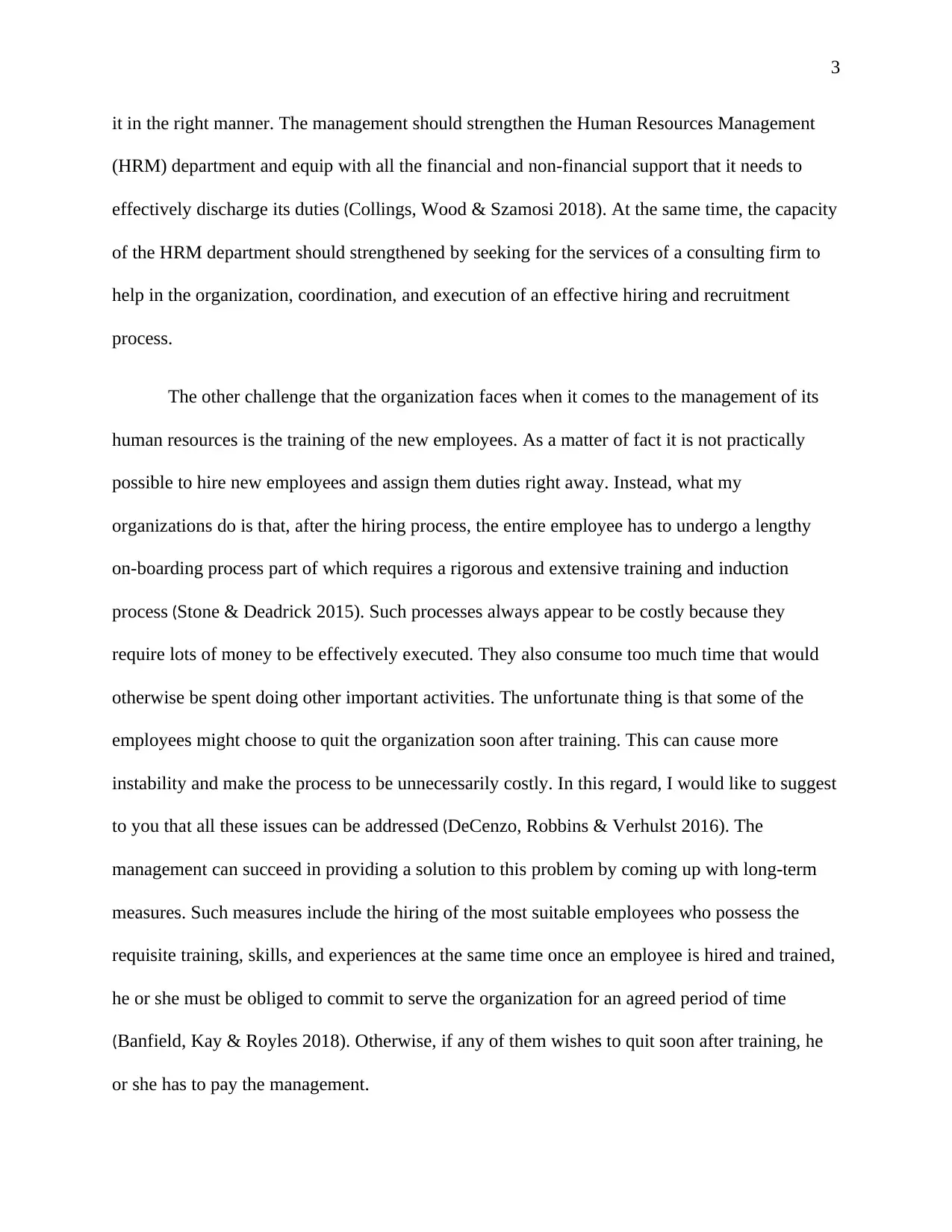
3
it in the right manner. The management should strengthen the Human Resources Management
(HRM) department and equip with all the financial and non-financial support that it needs to
effectively discharge its duties (Collings, Wood & Szamosi 2018). At the same time, the capacity
of the HRM department should strengthened by seeking for the services of a consulting firm to
help in the organization, coordination, and execution of an effective hiring and recruitment
process.
The other challenge that the organization faces when it comes to the management of its
human resources is the training of the new employees. As a matter of fact it is not practically
possible to hire new employees and assign them duties right away. Instead, what my
organizations do is that, after the hiring process, the entire employee has to undergo a lengthy
on-boarding process part of which requires a rigorous and extensive training and induction
process (Stone & Deadrick 2015). Such processes always appear to be costly because they
require lots of money to be effectively executed. They also consume too much time that would
otherwise be spent doing other important activities. The unfortunate thing is that some of the
employees might choose to quit the organization soon after training. This can cause more
instability and make the process to be unnecessarily costly. In this regard, I would like to suggest
to you that all these issues can be addressed (DeCenzo, Robbins & Verhulst 2016). The
management can succeed in providing a solution to this problem by coming up with long-term
measures. Such measures include the hiring of the most suitable employees who possess the
requisite training, skills, and experiences at the same time once an employee is hired and trained,
he or she must be obliged to commit to serve the organization for an agreed period of time
(Banfield, Kay & Royles 2018). Otherwise, if any of them wishes to quit soon after training, he
or she has to pay the management.
it in the right manner. The management should strengthen the Human Resources Management
(HRM) department and equip with all the financial and non-financial support that it needs to
effectively discharge its duties (Collings, Wood & Szamosi 2018). At the same time, the capacity
of the HRM department should strengthened by seeking for the services of a consulting firm to
help in the organization, coordination, and execution of an effective hiring and recruitment
process.
The other challenge that the organization faces when it comes to the management of its
human resources is the training of the new employees. As a matter of fact it is not practically
possible to hire new employees and assign them duties right away. Instead, what my
organizations do is that, after the hiring process, the entire employee has to undergo a lengthy
on-boarding process part of which requires a rigorous and extensive training and induction
process (Stone & Deadrick 2015). Such processes always appear to be costly because they
require lots of money to be effectively executed. They also consume too much time that would
otherwise be spent doing other important activities. The unfortunate thing is that some of the
employees might choose to quit the organization soon after training. This can cause more
instability and make the process to be unnecessarily costly. In this regard, I would like to suggest
to you that all these issues can be addressed (DeCenzo, Robbins & Verhulst 2016). The
management can succeed in providing a solution to this problem by coming up with long-term
measures. Such measures include the hiring of the most suitable employees who possess the
requisite training, skills, and experiences at the same time once an employee is hired and trained,
he or she must be obliged to commit to serve the organization for an agreed period of time
(Banfield, Kay & Royles 2018). Otherwise, if any of them wishes to quit soon after training, he
or she has to pay the management.
⊘ This is a preview!⊘
Do you want full access?
Subscribe today to unlock all pages.

Trusted by 1+ million students worldwide
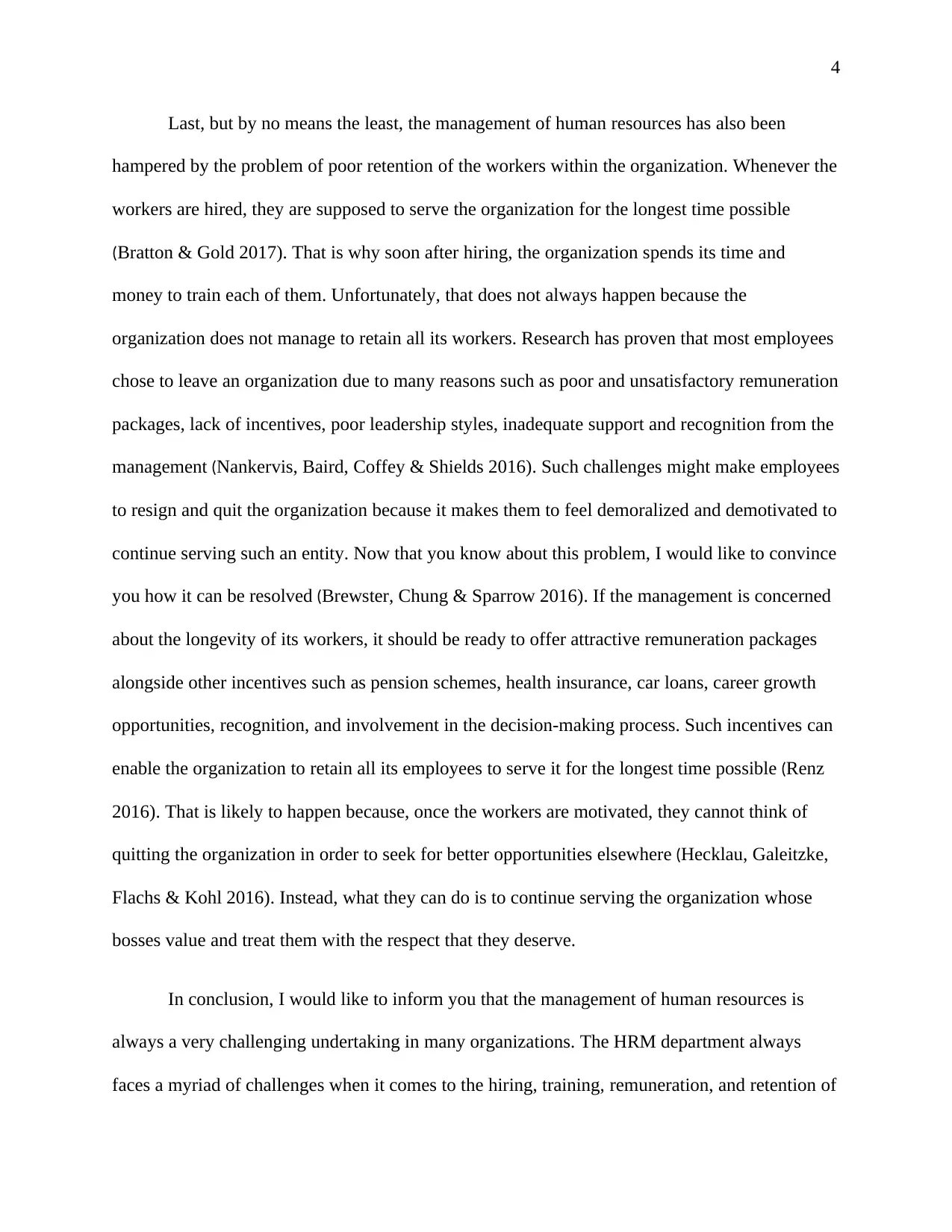
4
Last, but by no means the least, the management of human resources has also been
hampered by the problem of poor retention of the workers within the organization. Whenever the
workers are hired, they are supposed to serve the organization for the longest time possible
(Bratton & Gold 2017). That is why soon after hiring, the organization spends its time and
money to train each of them. Unfortunately, that does not always happen because the
organization does not manage to retain all its workers. Research has proven that most employees
chose to leave an organization due to many reasons such as poor and unsatisfactory remuneration
packages, lack of incentives, poor leadership styles, inadequate support and recognition from the
management (Nankervis, Baird, Coffey & Shields 2016). Such challenges might make employees
to resign and quit the organization because it makes them to feel demoralized and demotivated to
continue serving such an entity. Now that you know about this problem, I would like to convince
you how it can be resolved (Brewster, Chung & Sparrow 2016). If the management is concerned
about the longevity of its workers, it should be ready to offer attractive remuneration packages
alongside other incentives such as pension schemes, health insurance, car loans, career growth
opportunities, recognition, and involvement in the decision-making process. Such incentives can
enable the organization to retain all its employees to serve it for the longest time possible (Renz
2016). That is likely to happen because, once the workers are motivated, they cannot think of
quitting the organization in order to seek for better opportunities elsewhere (Hecklau, Galeitzke,
Flachs & Kohl 2016). Instead, what they can do is to continue serving the organization whose
bosses value and treat them with the respect that they deserve.
In conclusion, I would like to inform you that the management of human resources is
always a very challenging undertaking in many organizations. The HRM department always
faces a myriad of challenges when it comes to the hiring, training, remuneration, and retention of
Last, but by no means the least, the management of human resources has also been
hampered by the problem of poor retention of the workers within the organization. Whenever the
workers are hired, they are supposed to serve the organization for the longest time possible
(Bratton & Gold 2017). That is why soon after hiring, the organization spends its time and
money to train each of them. Unfortunately, that does not always happen because the
organization does not manage to retain all its workers. Research has proven that most employees
chose to leave an organization due to many reasons such as poor and unsatisfactory remuneration
packages, lack of incentives, poor leadership styles, inadequate support and recognition from the
management (Nankervis, Baird, Coffey & Shields 2016). Such challenges might make employees
to resign and quit the organization because it makes them to feel demoralized and demotivated to
continue serving such an entity. Now that you know about this problem, I would like to convince
you how it can be resolved (Brewster, Chung & Sparrow 2016). If the management is concerned
about the longevity of its workers, it should be ready to offer attractive remuneration packages
alongside other incentives such as pension schemes, health insurance, car loans, career growth
opportunities, recognition, and involvement in the decision-making process. Such incentives can
enable the organization to retain all its employees to serve it for the longest time possible (Renz
2016). That is likely to happen because, once the workers are motivated, they cannot think of
quitting the organization in order to seek for better opportunities elsewhere (Hecklau, Galeitzke,
Flachs & Kohl 2016). Instead, what they can do is to continue serving the organization whose
bosses value and treat them with the respect that they deserve.
In conclusion, I would like to inform you that the management of human resources is
always a very challenging undertaking in many organizations. The HRM department always
faces a myriad of challenges when it comes to the hiring, training, remuneration, and retention of
Paraphrase This Document
Need a fresh take? Get an instant paraphrase of this document with our AI Paraphraser
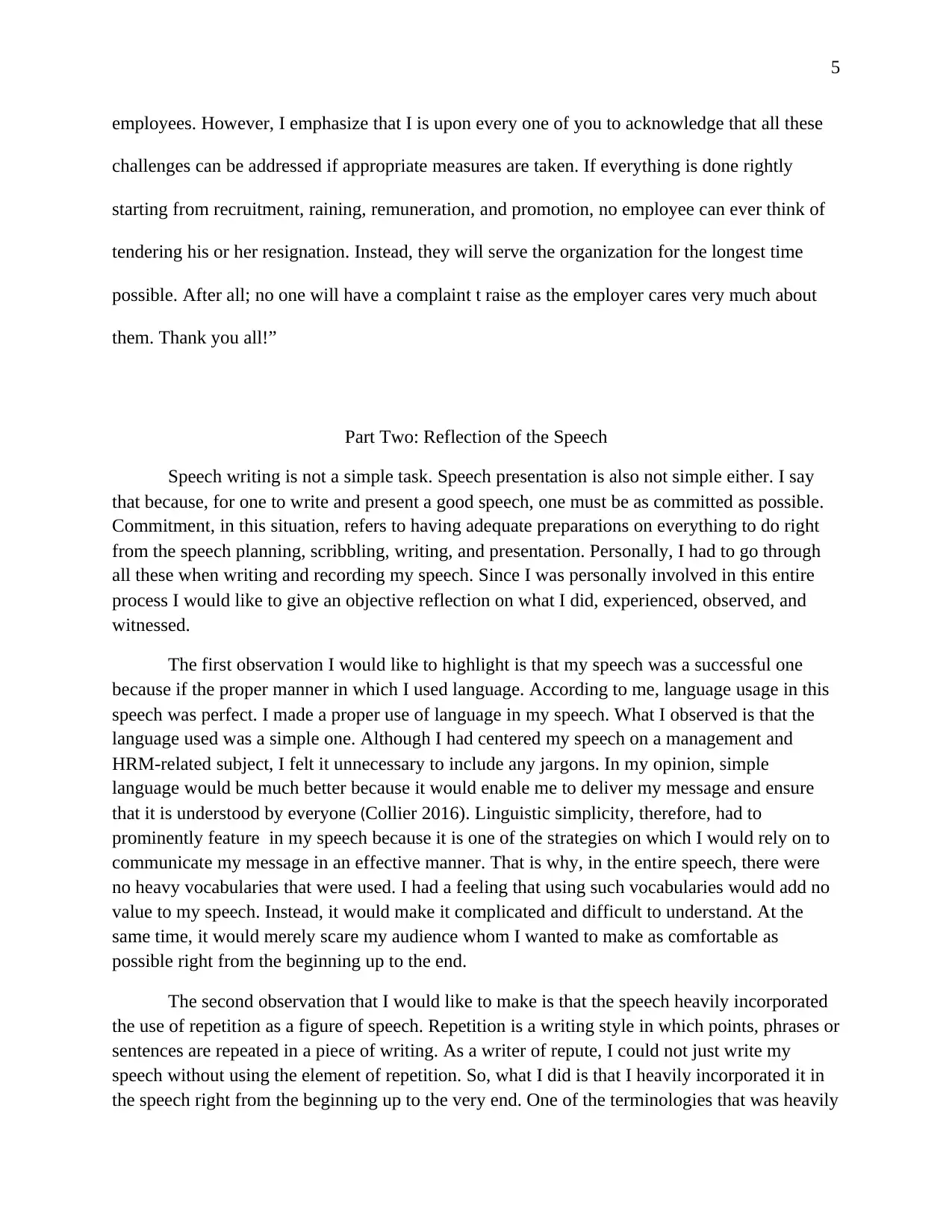
5
employees. However, I emphasize that I is upon every one of you to acknowledge that all these
challenges can be addressed if appropriate measures are taken. If everything is done rightly
starting from recruitment, raining, remuneration, and promotion, no employee can ever think of
tendering his or her resignation. Instead, they will serve the organization for the longest time
possible. After all; no one will have a complaint t raise as the employer cares very much about
them. Thank you all!”
Part Two: Reflection of the Speech
Speech writing is not a simple task. Speech presentation is also not simple either. I say
that because, for one to write and present a good speech, one must be as committed as possible.
Commitment, in this situation, refers to having adequate preparations on everything to do right
from the speech planning, scribbling, writing, and presentation. Personally, I had to go through
all these when writing and recording my speech. Since I was personally involved in this entire
process I would like to give an objective reflection on what I did, experienced, observed, and
witnessed.
The first observation I would like to highlight is that my speech was a successful one
because if the proper manner in which I used language. According to me, language usage in this
speech was perfect. I made a proper use of language in my speech. What I observed is that the
language used was a simple one. Although I had centered my speech on a management and
HRM-related subject, I felt it unnecessary to include any jargons. In my opinion, simple
language would be much better because it would enable me to deliver my message and ensure
that it is understood by everyone (Collier 2016). Linguistic simplicity, therefore, had to
prominently feature in my speech because it is one of the strategies on which I would rely on to
communicate my message in an effective manner. That is why, in the entire speech, there were
no heavy vocabularies that were used. I had a feeling that using such vocabularies would add no
value to my speech. Instead, it would make it complicated and difficult to understand. At the
same time, it would merely scare my audience whom I wanted to make as comfortable as
possible right from the beginning up to the end.
The second observation that I would like to make is that the speech heavily incorporated
the use of repetition as a figure of speech. Repetition is a writing style in which points, phrases or
sentences are repeated in a piece of writing. As a writer of repute, I could not just write my
speech without using the element of repetition. So, what I did is that I heavily incorporated it in
the speech right from the beginning up to the very end. One of the terminologies that was heavily
employees. However, I emphasize that I is upon every one of you to acknowledge that all these
challenges can be addressed if appropriate measures are taken. If everything is done rightly
starting from recruitment, raining, remuneration, and promotion, no employee can ever think of
tendering his or her resignation. Instead, they will serve the organization for the longest time
possible. After all; no one will have a complaint t raise as the employer cares very much about
them. Thank you all!”
Part Two: Reflection of the Speech
Speech writing is not a simple task. Speech presentation is also not simple either. I say
that because, for one to write and present a good speech, one must be as committed as possible.
Commitment, in this situation, refers to having adequate preparations on everything to do right
from the speech planning, scribbling, writing, and presentation. Personally, I had to go through
all these when writing and recording my speech. Since I was personally involved in this entire
process I would like to give an objective reflection on what I did, experienced, observed, and
witnessed.
The first observation I would like to highlight is that my speech was a successful one
because if the proper manner in which I used language. According to me, language usage in this
speech was perfect. I made a proper use of language in my speech. What I observed is that the
language used was a simple one. Although I had centered my speech on a management and
HRM-related subject, I felt it unnecessary to include any jargons. In my opinion, simple
language would be much better because it would enable me to deliver my message and ensure
that it is understood by everyone (Collier 2016). Linguistic simplicity, therefore, had to
prominently feature in my speech because it is one of the strategies on which I would rely on to
communicate my message in an effective manner. That is why, in the entire speech, there were
no heavy vocabularies that were used. I had a feeling that using such vocabularies would add no
value to my speech. Instead, it would make it complicated and difficult to understand. At the
same time, it would merely scare my audience whom I wanted to make as comfortable as
possible right from the beginning up to the end.
The second observation that I would like to make is that the speech heavily incorporated
the use of repetition as a figure of speech. Repetition is a writing style in which points, phrases or
sentences are repeated in a piece of writing. As a writer of repute, I could not just write my
speech without using the element of repetition. So, what I did is that I heavily incorporated it in
the speech right from the beginning up to the very end. One of the terminologies that was heavily
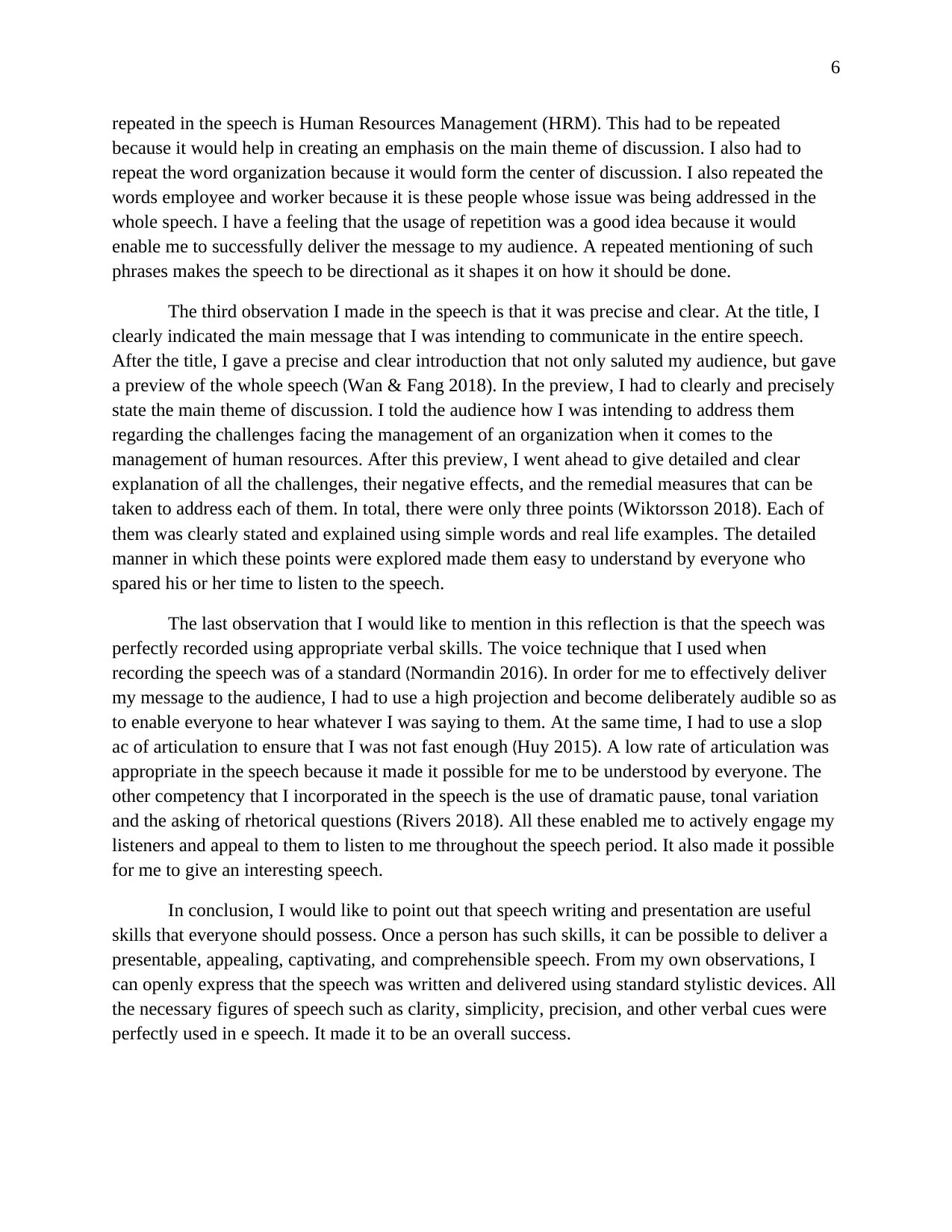
6
repeated in the speech is Human Resources Management (HRM). This had to be repeated
because it would help in creating an emphasis on the main theme of discussion. I also had to
repeat the word organization because it would form the center of discussion. I also repeated the
words employee and worker because it is these people whose issue was being addressed in the
whole speech. I have a feeling that the usage of repetition was a good idea because it would
enable me to successfully deliver the message to my audience. A repeated mentioning of such
phrases makes the speech to be directional as it shapes it on how it should be done.
The third observation I made in the speech is that it was precise and clear. At the title, I
clearly indicated the main message that I was intending to communicate in the entire speech.
After the title, I gave a precise and clear introduction that not only saluted my audience, but gave
a preview of the whole speech (Wan & Fang 2018). In the preview, I had to clearly and precisely
state the main theme of discussion. I told the audience how I was intending to address them
regarding the challenges facing the management of an organization when it comes to the
management of human resources. After this preview, I went ahead to give detailed and clear
explanation of all the challenges, their negative effects, and the remedial measures that can be
taken to address each of them. In total, there were only three points (Wiktorsson 2018). Each of
them was clearly stated and explained using simple words and real life examples. The detailed
manner in which these points were explored made them easy to understand by everyone who
spared his or her time to listen to the speech.
The last observation that I would like to mention in this reflection is that the speech was
perfectly recorded using appropriate verbal skills. The voice technique that I used when
recording the speech was of a standard (Normandin 2016). In order for me to effectively deliver
my message to the audience, I had to use a high projection and become deliberately audible so as
to enable everyone to hear whatever I was saying to them. At the same time, I had to use a slop
ac of articulation to ensure that I was not fast enough (Huy 2015). A low rate of articulation was
appropriate in the speech because it made it possible for me to be understood by everyone. The
other competency that I incorporated in the speech is the use of dramatic pause, tonal variation
and the asking of rhetorical questions (Rivers 2018). All these enabled me to actively engage my
listeners and appeal to them to listen to me throughout the speech period. It also made it possible
for me to give an interesting speech.
In conclusion, I would like to point out that speech writing and presentation are useful
skills that everyone should possess. Once a person has such skills, it can be possible to deliver a
presentable, appealing, captivating, and comprehensible speech. From my own observations, I
can openly express that the speech was written and delivered using standard stylistic devices. All
the necessary figures of speech such as clarity, simplicity, precision, and other verbal cues were
perfectly used in e speech. It made it to be an overall success.
repeated in the speech is Human Resources Management (HRM). This had to be repeated
because it would help in creating an emphasis on the main theme of discussion. I also had to
repeat the word organization because it would form the center of discussion. I also repeated the
words employee and worker because it is these people whose issue was being addressed in the
whole speech. I have a feeling that the usage of repetition was a good idea because it would
enable me to successfully deliver the message to my audience. A repeated mentioning of such
phrases makes the speech to be directional as it shapes it on how it should be done.
The third observation I made in the speech is that it was precise and clear. At the title, I
clearly indicated the main message that I was intending to communicate in the entire speech.
After the title, I gave a precise and clear introduction that not only saluted my audience, but gave
a preview of the whole speech (Wan & Fang 2018). In the preview, I had to clearly and precisely
state the main theme of discussion. I told the audience how I was intending to address them
regarding the challenges facing the management of an organization when it comes to the
management of human resources. After this preview, I went ahead to give detailed and clear
explanation of all the challenges, their negative effects, and the remedial measures that can be
taken to address each of them. In total, there were only three points (Wiktorsson 2018). Each of
them was clearly stated and explained using simple words and real life examples. The detailed
manner in which these points were explored made them easy to understand by everyone who
spared his or her time to listen to the speech.
The last observation that I would like to mention in this reflection is that the speech was
perfectly recorded using appropriate verbal skills. The voice technique that I used when
recording the speech was of a standard (Normandin 2016). In order for me to effectively deliver
my message to the audience, I had to use a high projection and become deliberately audible so as
to enable everyone to hear whatever I was saying to them. At the same time, I had to use a slop
ac of articulation to ensure that I was not fast enough (Huy 2015). A low rate of articulation was
appropriate in the speech because it made it possible for me to be understood by everyone. The
other competency that I incorporated in the speech is the use of dramatic pause, tonal variation
and the asking of rhetorical questions (Rivers 2018). All these enabled me to actively engage my
listeners and appeal to them to listen to me throughout the speech period. It also made it possible
for me to give an interesting speech.
In conclusion, I would like to point out that speech writing and presentation are useful
skills that everyone should possess. Once a person has such skills, it can be possible to deliver a
presentable, appealing, captivating, and comprehensible speech. From my own observations, I
can openly express that the speech was written and delivered using standard stylistic devices. All
the necessary figures of speech such as clarity, simplicity, precision, and other verbal cues were
perfectly used in e speech. It made it to be an overall success.
⊘ This is a preview!⊘
Do you want full access?
Subscribe today to unlock all pages.

Trusted by 1+ million students worldwide
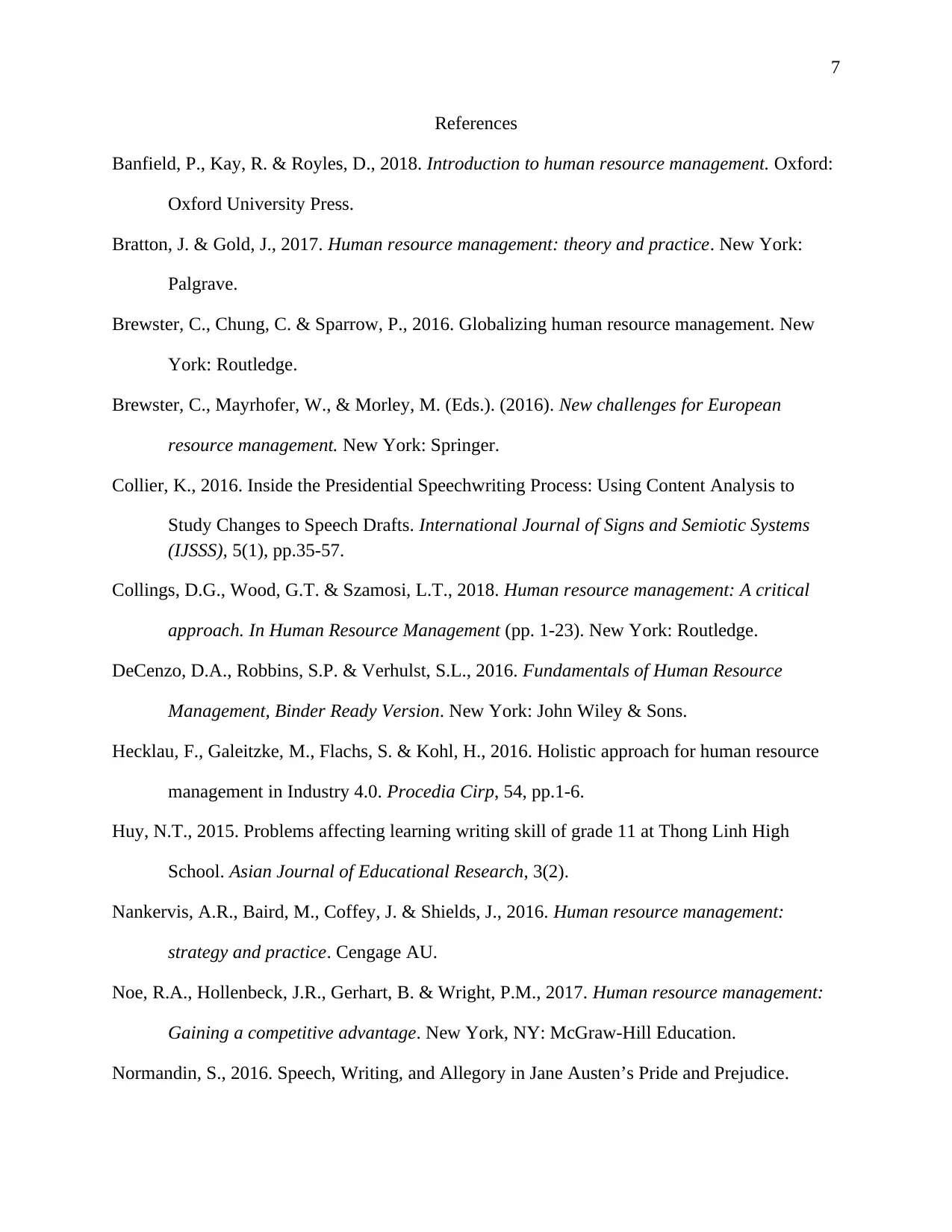
7
References
Banfield, P., Kay, R. & Royles, D., 2018. Introduction to human resource management. Oxford:
Oxford University Press.
Bratton, J. & Gold, J., 2017. Human resource management: theory and practice. New York:
Palgrave.
Brewster, C., Chung, C. & Sparrow, P., 2016. Globalizing human resource management. New
York: Routledge.
Brewster, C., Mayrhofer, W., & Morley, M. (Eds.). (2016). New challenges for European
resource management. New York: Springer.
Collier, K., 2016. Inside the Presidential Speechwriting Process: Using Content Analysis to
Study Changes to Speech Drafts. International Journal of Signs and Semiotic Systems
(IJSSS), 5(1), pp.35-57.
Collings, D.G., Wood, G.T. & Szamosi, L.T., 2018. Human resource management: A critical
approach. In Human Resource Management (pp. 1-23). New York: Routledge.
DeCenzo, D.A., Robbins, S.P. & Verhulst, S.L., 2016. Fundamentals of Human Resource
Management, Binder Ready Version. New York: John Wiley & Sons.
Hecklau, F., Galeitzke, M., Flachs, S. & Kohl, H., 2016. Holistic approach for human resource
management in Industry 4.0. Procedia Cirp, 54, pp.1-6.
Huy, N.T., 2015. Problems affecting learning writing skill of grade 11 at Thong Linh High
School. Asian Journal of Educational Research, 3(2).
Nankervis, A.R., Baird, M., Coffey, J. & Shields, J., 2016. Human resource management:
strategy and practice. Cengage AU.
Noe, R.A., Hollenbeck, J.R., Gerhart, B. & Wright, P.M., 2017. Human resource management:
Gaining a competitive advantage. New York, NY: McGraw-Hill Education.
Normandin, S., 2016. Speech, Writing, and Allegory in Jane Austen’s Pride and Prejudice.
References
Banfield, P., Kay, R. & Royles, D., 2018. Introduction to human resource management. Oxford:
Oxford University Press.
Bratton, J. & Gold, J., 2017. Human resource management: theory and practice. New York:
Palgrave.
Brewster, C., Chung, C. & Sparrow, P., 2016. Globalizing human resource management. New
York: Routledge.
Brewster, C., Mayrhofer, W., & Morley, M. (Eds.). (2016). New challenges for European
resource management. New York: Springer.
Collier, K., 2016. Inside the Presidential Speechwriting Process: Using Content Analysis to
Study Changes to Speech Drafts. International Journal of Signs and Semiotic Systems
(IJSSS), 5(1), pp.35-57.
Collings, D.G., Wood, G.T. & Szamosi, L.T., 2018. Human resource management: A critical
approach. In Human Resource Management (pp. 1-23). New York: Routledge.
DeCenzo, D.A., Robbins, S.P. & Verhulst, S.L., 2016. Fundamentals of Human Resource
Management, Binder Ready Version. New York: John Wiley & Sons.
Hecklau, F., Galeitzke, M., Flachs, S. & Kohl, H., 2016. Holistic approach for human resource
management in Industry 4.0. Procedia Cirp, 54, pp.1-6.
Huy, N.T., 2015. Problems affecting learning writing skill of grade 11 at Thong Linh High
School. Asian Journal of Educational Research, 3(2).
Nankervis, A.R., Baird, M., Coffey, J. & Shields, J., 2016. Human resource management:
strategy and practice. Cengage AU.
Noe, R.A., Hollenbeck, J.R., Gerhart, B. & Wright, P.M., 2017. Human resource management:
Gaining a competitive advantage. New York, NY: McGraw-Hill Education.
Normandin, S., 2016. Speech, Writing, and Allegory in Jane Austen’s Pride and Prejudice.
Paraphrase This Document
Need a fresh take? Get an instant paraphrase of this document with our AI Paraphraser
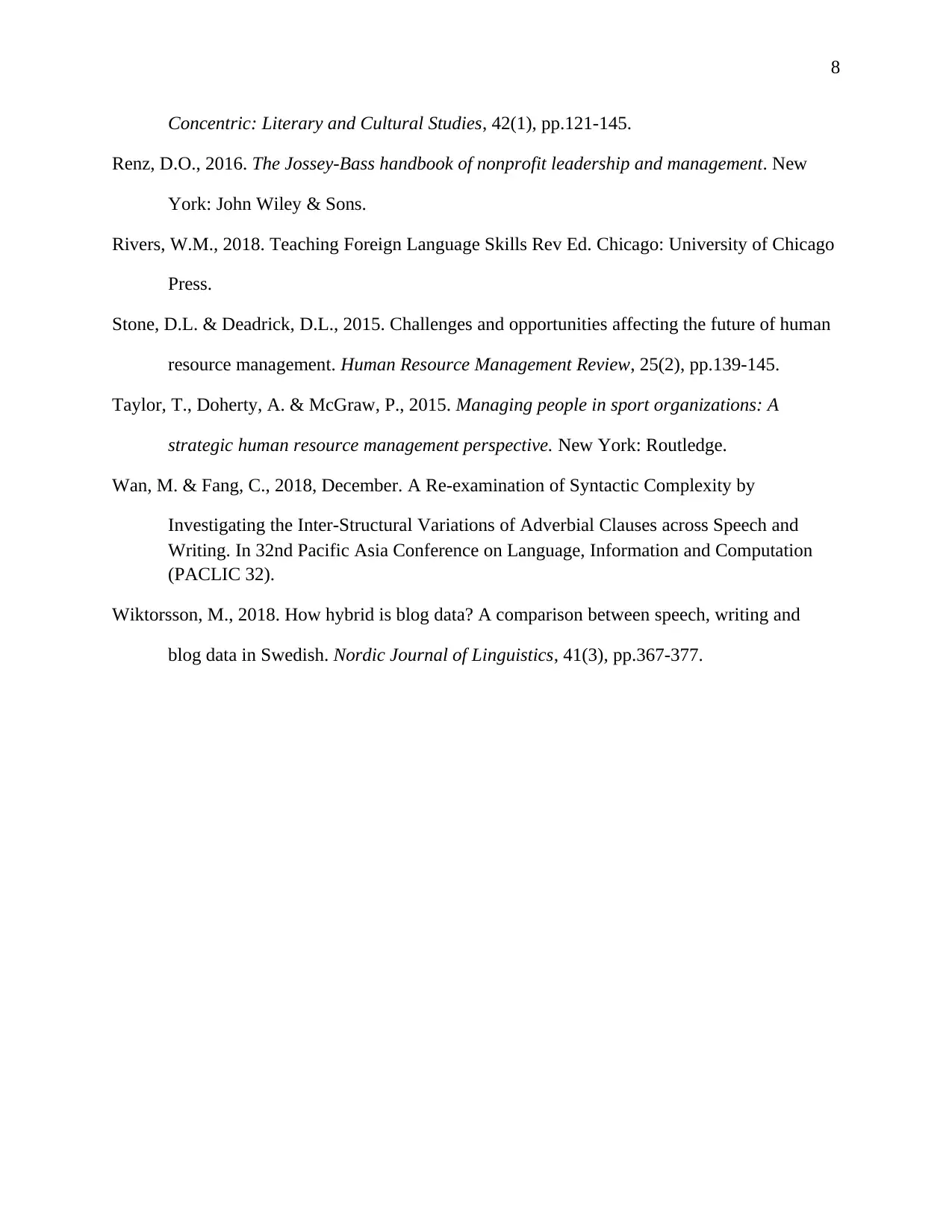
8
Concentric: Literary and Cultural Studies, 42(1), pp.121-145.
Renz, D.O., 2016. The Jossey-Bass handbook of nonprofit leadership and management. New
York: John Wiley & Sons.
Rivers, W.M., 2018. Teaching Foreign Language Skills Rev Ed. Chicago: University of Chicago
Press.
Stone, D.L. & Deadrick, D.L., 2015. Challenges and opportunities affecting the future of human
resource management. Human Resource Management Review, 25(2), pp.139-145.
Taylor, T., Doherty, A. & McGraw, P., 2015. Managing people in sport organizations: A
strategic human resource management perspective. New York: Routledge.
Wan, M. & Fang, C., 2018, December. A Re-examination of Syntactic Complexity by
Investigating the Inter-Structural Variations of Adverbial Clauses across Speech and
Writing. In 32nd Pacific Asia Conference on Language, Information and Computation
(PACLIC 32).
Wiktorsson, M., 2018. How hybrid is blog data? A comparison between speech, writing and
blog data in Swedish. Nordic Journal of Linguistics, 41(3), pp.367-377.
Concentric: Literary and Cultural Studies, 42(1), pp.121-145.
Renz, D.O., 2016. The Jossey-Bass handbook of nonprofit leadership and management. New
York: John Wiley & Sons.
Rivers, W.M., 2018. Teaching Foreign Language Skills Rev Ed. Chicago: University of Chicago
Press.
Stone, D.L. & Deadrick, D.L., 2015. Challenges and opportunities affecting the future of human
resource management. Human Resource Management Review, 25(2), pp.139-145.
Taylor, T., Doherty, A. & McGraw, P., 2015. Managing people in sport organizations: A
strategic human resource management perspective. New York: Routledge.
Wan, M. & Fang, C., 2018, December. A Re-examination of Syntactic Complexity by
Investigating the Inter-Structural Variations of Adverbial Clauses across Speech and
Writing. In 32nd Pacific Asia Conference on Language, Information and Computation
(PACLIC 32).
Wiktorsson, M., 2018. How hybrid is blog data? A comparison between speech, writing and
blog data in Swedish. Nordic Journal of Linguistics, 41(3), pp.367-377.
1 out of 8
Related Documents
Your All-in-One AI-Powered Toolkit for Academic Success.
+13062052269
info@desklib.com
Available 24*7 on WhatsApp / Email
![[object Object]](/_next/static/media/star-bottom.7253800d.svg)
Unlock your academic potential
Copyright © 2020–2025 A2Z Services. All Rights Reserved. Developed and managed by ZUCOL.

